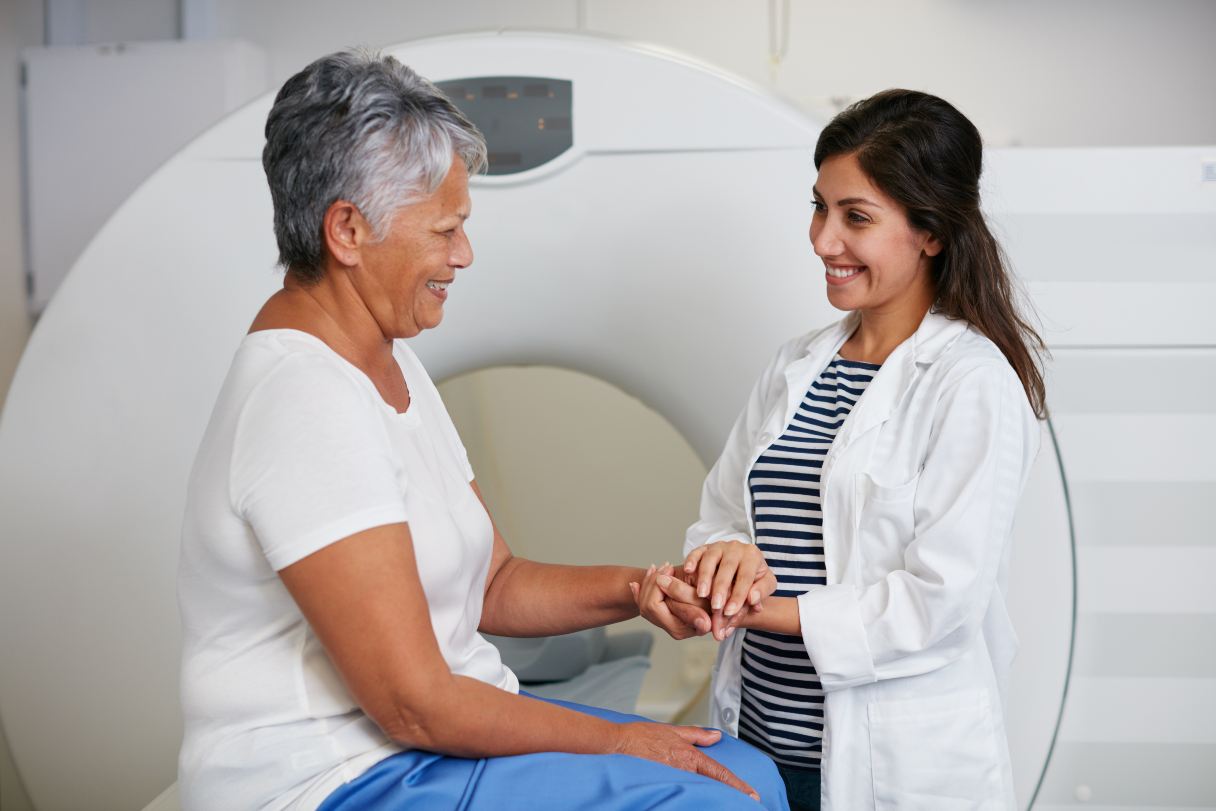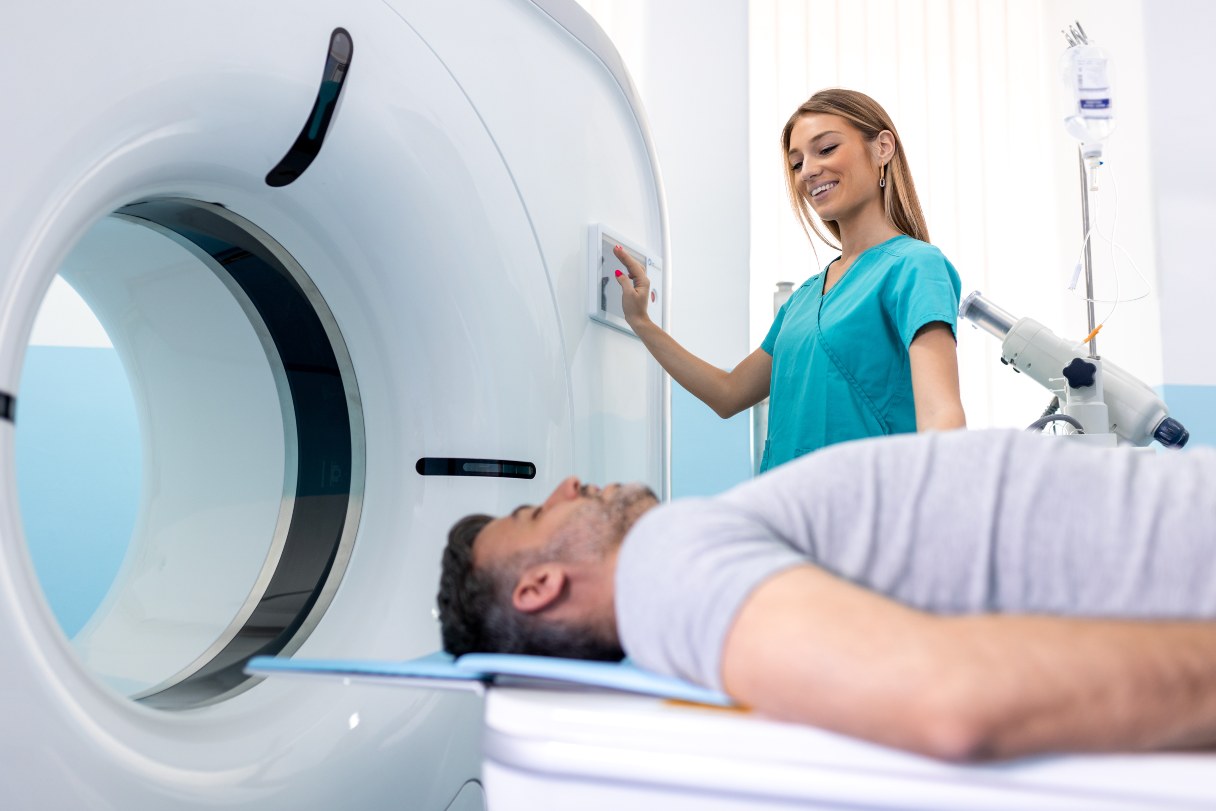Whether it's called a CT scan, a CAT scan or a computed tomography scan, this noninvasive imaging procedure helps doctors get internal pictures of the body to help them diagnose and treat various conditions.
More than 80 million CT scans are performed each year in the U.S.,1 and if you've recently had your first CT scan ordered, you might have questions — like what exactly a CT scan is, what to expect during the procedure, how much a CT scan can cost and how to pay for it.
What Is a CT Scan?
A computed tomography scan, commonly known as a CT scan, is a noninvasive imaging procedure that uses a collection of X-rays to create a detailed picture of a person's bones and soft tissue. The test may also be called a CAT scan or computed axial tomography scan.2
CT scans can capture images of a variety of internal structures, including:2
- Bones
- Organs
- Muscles
- Blood vessels
By combining multiple X-ray images, CT scans allow medical professionals to have a more complete and more precise picture of a person's internal structures and any potential injuries or abnormalities.
CT scan with contrast
Some CT scans are performed "with contrast," which requires a special dye to be ingested or injected intravenously into the veins to allow for better visibility of certain areas of the body on the CT scan. The dye blocks the X-rays and shows up as white on the images, which can help clarify images of organs, blood vessels or other soft tissue.3
CT scan vs. X-ray
X-rays take pictures from one direction and produce flat, 2D images of bones and soft tissue. CT scans, however, combine dozens of X-rays while the machine rotates around, giving doctors a 3D perspective of your bones, internal organs and structures.2
CT scan vs. MRI
An MRI, or magnetic resonance imaging, also produces an image of internal structures but relies on magnets and radio waves instead of X-rays. MRIs are more commonly used on soft tissue such as nerves, muscles, ligaments or tendons.2
Why Are CT Scans Used?
There are a number of different reasons that a CT scan might be ordered. CT scans can be used to:3
- Detect internal injuries
- Diagnose internal disorders
- Locate the source of infection, tumors or blood clots
- Guide treatment during surgery, radiation or biopsy
- Monitor the growth or changes of internal structures
CT scans may be ordered if there is a risk of:2
- Fractured or broken bones
- Blood clots
- Heart disease
- Certain kinds of cancers
- Noncancerous tumors
- Internal bleeding
- Kidney stones
- Brain injuries
- Spinal cord injuries
Where to Get a CT Scan
CT scans can be performed at a hospital or imaging center.2 Where you get a CT scan may depend on the particular medical condition, the urgency of the issue and your health insurance.
How Much Does a CT Scan Cost?
On average, a CT scan can cost anywhere between $300 and $6,750.4 Some of the factors that can impact the price of a CT scan include:4
- Part of the body being scanned
- Service provider
- Imaging center vs. hospital
- Geographic location
- Insurance plan
- Cost of reading results
Here are some examples of average CT scan costs based on geographic location.4
| Location | Average CT Scan Cost |
|---|---|
|
Chicago |
$822 |
|
Houston |
$1,436 |
|
Los Angeles |
$1,352 |
|
Philadelphia |
$1,415 |
And here are some examples of the range of costs associated with a CT scan, without insurance, based on the part of the body being scanned (with or without contrast).5
| Body Part | CT Scan Cost Range |
|---|---|
| Abdomen | $1,750 to $9,500 |
| Head or brain | $825 to $4,800 |
| Chest | $675 to $8,600 |
| Pelvis | $1,700 to $10,200 |
| Shoulder, arm, wrist, hand | $625 to $8,400 |
| Foot, ankle, leg, hip | $640 to $11,200 |
Are CT Scans Covered by Insurance?
The cost of CT scans with insurance can vary by coverage and condition. Some insurance policies may cover the entire cost of a CT scan, while others may require a copay or deductible. Some insurance policies may cover all or only part of the cost of a CT scan if the CT scan has been specifically ordered by a medical professional; others may require pre-authorization before getting a CT scan. If it is an elective CT scan, the cost may need to be paid entirely out of pocket.6
How to pay for a CT scan
Talk with your provider about ways to pay for CT scans. You may be able to pay with your health insurance, out of pocket or with the CareCredit credit card.* Some imaging centers may also offer in-house financing or payment plans. There may also be assistance programs available depending on your unique circumstances.
What Happens During a CT Scan?
During a CT scan, the patient lays on a table that moves into a doughnut-shaped machine. A portion of the machine rotates around, taking multiple X-rays that are later combined into one image.3
While the table moves into the scanner, you may hear some whirring or buzzing noises during the imaging.3 However, a CT scan is much quieter than an MRI.2 While the procedure is painless, the technician may ask you to hold your breath at some points to ensure clear imaging.3 A CT scan usually takes only 10 to 15 minutes.2
Preparation
You may be asked to not eat before the procedure. Depending on the body part that needs to be scanned, you may be given a hospital gown to change into. In order to get clear images, pillows or straps may be used to help keep your body steady. If your procedure requires contrast, you will be given an IV or something to drink containing the contrast dye.3
Recovery
There is no downtime after a CT scan, and patients are able to return immediately to work, school and everyday activities. If contrast was used, you may receive special instructions to drink additional water to help flush the contrast from your system.3
Risks and Side Effects of CT Scans
Most people do not experience any immediate side effects from CT scans. If the CT scan required contrast, some individuals can have an allergic reaction.2
CT scans rely on X-rays, which do use small amounts of ionizing radiation to capture images. While this kind of radiation can damage your DNA, the risk is very small.7 When used appropriately, the benefits of a CT scan usually exceed the potential risks, according to the U.S. Food & Drug Administration (FDA)8 and the Environmental Protection Agency (EPA).9
To limit your risks from CT scans, consider keeping track of your X-ray history, asking if there are alternative imaging methods (MRI, ultrasound, etc.) and do not seek out unnecessary CT scans.1
How Long Do CT Scan Results Take?
In most cases, CT scans are read by a radiologist within 24 to 48 hours. In an emergency, a healthcare professional can receive results more quickly. After receiving the radiologist report, you will usually have a call or appointment with your primary care physician to explain the results and discuss any next steps.2
Managing Health & Wellness Costs With the CareCredit Credit Card
If you are looking for an option to help manage your health & wellness costs, consider financing with the CareCredit credit card. The CareCredit credit card can help you pay for the care you want and need and make payments easy to manage.* Apply today and use our Acceptance Locator to find a provider near you that accepts CareCredit. Continue your wellness journey by downloading the CareCredit Mobile App to manage your account, find a provider on the go and easily access the Well U hub for more great articles, podcasts and videos.
Author Bio
Kate Bayless is a health and wellness freelance writer with 15 years of experience. Her work has appeared in Parents, Women's Health, Beachbody and OpenFit.








